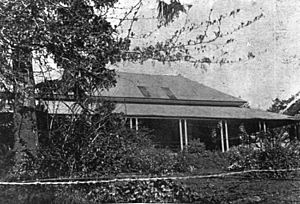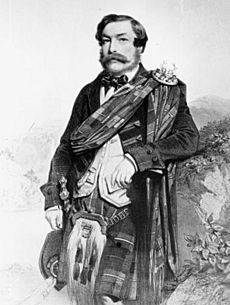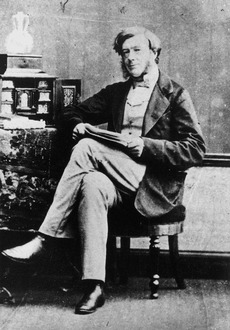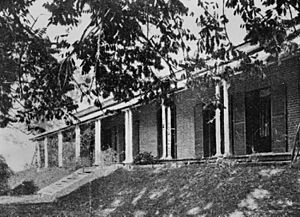Kilcoy Homestead facts for kids
Quick facts for kids Kilcoy Homestead |
|
|---|---|
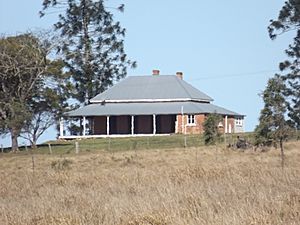
Building in 2015
|
|
| Location | Kilcoy-Murgon Road, Kilcoy, Somerset Region, Queensland, Australia |
| Design period | 1840s–1860s (mid-19th century) |
| Built | c. 1857 |
| Official name: Kilcoy Homestead | |
| Type | state heritage (landscape, built) |
| Designated | 21 October 1992 |
| Reference no. | 600638 |
| Significant period | 1850s (historical) 1850s (fabric) |
| Significant components | garden/grounds, shed/s, trees/plantings, residential accommodation – main house |
| Lua error in Module:Location_map at line 420: attempt to index field 'wikibase' (a nil value). | |
Kilcoy Homestead is a very old and important house located near Kilcoy in Queensland, Australia. It was built around 1857. This special place is listed on the Queensland Heritage Register because it tells us a lot about the early history of Queensland.
Contents
History of Kilcoy Homestead
Kilcoy Homestead is a large brick house with one floor. It was built around 1857 for a very important person named Louis Hope. He was a British aristocrat, which means he came from a noble family. He was also a grazier (someone who raises livestock) and owned sugar plantations in Queensland. He was even a politician!
Early Days of Kilcoy Station
The land where Kilcoy Homestead stands was first used for farming sheep. Two brothers, Evan and Colin Mackenzie, started clearing the land in 1841. They were from Kilcoy, Scotland. In October 1841, they officially got the licence to use the land. This was only the second farming licence given for the Upper Brisbane Valley.
By 1848, the Kilcoy area was huge. It covered over 35,000 acres. It had borders with other large farms like Mount Brisbane Station and Durundur Station. Starting Kilcoy Station was difficult because of the local Aboriginal people. There were many challenges during this time.
First Homes at Kilcoy
The very first home built at Kilcoy in 1841 was a simple hut made of wooden slabs. In 1844, a new brick house was built. This house had five rooms, including a large living room and four bedrooms. There was also a verandah at the front. The kitchen was in a separate building about 40 yards away. This old kitchen was taken down around 1928.
Louis Hope Takes Over
Evan Mackenzie left the area in 1845, even though his brother Colin stayed until about 1857. The Kilcoy land was sold to Charles A. Atherton in 1849. Then, in 1853, it was bought by Louis Hope and Robert Ramsay. It's not clear if Ramsay ever worked on the station. By 1857, Louis Hope was running it with a manager. They started making bricks on the property to build his new house, which is the Kilcoy Homestead we see today.
The old brick house from 1844 had a lot of white ants (termites). It was taken down when the new house was finished around 1857. In 1863, Louis Hope bought Ramsay's share of Kilcoy, becoming the sole owner.
Hope's Life and Other Properties
Louis Hope came to New South Wales in 1843. He was very active in Queensland's early economy and politics. He was also very important in starting the sugar industry in Queensland. In the 1850s, he bought and leased a lot of land. This included Kilcoy Station in 1853 and Shafston House in 1854.
Hope also owned land at Cleveland. He started farming there around 1858. In the early 1860s, he tried growing cotton, then sugar cane. He set up Queensland's first sugar plantation at Ormiston. Around 1864-1865, Hope built another large brick house at Ormiston, which was similar to Kilcoy Homestead but more fancy. After this, the Hope family mostly lived at Ormiston House. Kilcoy Homestead then became the home for the station manager. A smaller brick cottage was also built at Kilcoy for Louis Hope to use when he visited.
Later Owners and Managers
In 1871, William Butler became the manager of Kilcoy. He worked there for over 50 years! In 1882, the Hope family moved back to England. They left Kilcoy and Ormiston (which was rented out) under Butler's care. At Kilcoy, Butler got along very well with the local Aboriginal people. After he died, a street in Kilcoy was named after him, and a monument was built to honor him.
Louis Hope died in Switzerland in 1894. But Kilcoy Homestead stayed with his family until 1908. That year, William Butler bought the house and 524 acres of land. In 1924, a local farmer named Jeremiah Kennedy bought the homestead. He was very involved in local government and loved horse racing, just like the previous owners. Kilcoy Homestead is still owned by the Kennedy family today, though a caretaker lives there.
What Kilcoy Homestead Looks Like
Kilcoy Homestead is a brick house with one floor and a roof made of corrugated iron. It sits on a ridge (a long, narrow hill) north of Kilcoy. From the house, you can see Kilcoy Creek and the farms around it. The building's design looks a lot like the Georgian style, which was popular a long time ago. You reach the house by driving along the ridge from the southwest.
House Features
The house is shaped like an "L". It's built with a special brick pattern called English Bond. Verandahs (covered porches) go all around the house, but the one on the south side is now enclosed. French doors with shutters open onto these verandahs. The verandahs have corrugated iron roofs and wooden posts.
The main entrance is in the middle of the northeast side. You walk up brick steps to a verandah. The front door has double wooden panels, a fanlight (a window shaped like a fan above the door), and sidelights (windows on the sides of the door). This leads into the entrance hall. Another matching doorway leads into the hall from the enclosed back verandah.
Inside the Homestead
The main part of the house is one room deep. The northeast part has the central entrance hall. There's a bedroom on the north side and a living room on the south. At the southern end are storerooms. There are also brick storerooms at the back. The back wing has a large bedroom and an enclosed verandah on the south, which holds the kitchen. A brick lean-to (a small building attached to a larger one) at the back has the bathroom.
Inside, the walls are plastered. The ceilings are made of wooden boards. The skirting boards (along the bottom of the walls), doors, and architraves (frames around doors and windows) are made of cedar wood. The entrance hall floor is made of rough sandstone. Other main rooms have wooden floors. The two rooms on the northeast side have fireplaces with wooden frames. The kitchen and bathroom have been changed more recently. The southern storerooms have a loft space above them. There's also a basement wine cellar, but you can't get into it anymore. The lean-to storerooms at the back, one of which used to be a lamp room, have concrete floors.
Grounds and Other Buildings
The homestead grounds have old Bunya Pines and other native and European trees. There's a flat, terraced area northeast of the house that might have been an early tennis court.
You can still see the remains of a brick shed southwest of the house. It has two side walls, and one of them has a fireplace. The roof is a freestanding gable roof supported by metal posts. An old railway station building, which used to be called WINYA, has been moved onto the property. It's made of weatherboard with a corrugated iron gable roof. It's located between the homestead and the brick shed.
Further southwest, next to the driveway, are a dairy (where milk was processed) and stables. These are made of brick and timber with a corrugated iron gable roof.
Why Kilcoy Homestead is Important
Kilcoy Homestead was added to the Queensland Heritage Register on 21 October 1992. This means it's a very important historical site.
A Glimpse into Queensland's Past
Kilcoy Homestead is important because it's one of the oldest surviving homesteads in the Brisbane Valley and in all of Queensland. It was built around 1857 for Louis Hope, a very important pioneer. It shows us how farming and settlement grew in Queensland in the 1800s, especially in the Brisbane Valley.
A Rare and Special Building
This homestead is also special because it's a rare and well-preserved brick house from the late 1850s. Not many buildings like this were built back then, and even fewer are still standing today.
How Pioneers Lived
The homestead was built using local, handmade bricks and timber from the property. This shows us how early pioneers had to use what was available to build their homes in the bush. It also shows how clever they were at overcoming challenges.
Beautiful Design and Location
Kilcoy Homestead is a great example of an 1850s house with a strong Georgian design. Its impressive location on the ridge and the old trees around it make it a landmark in the area. The simple details and finishes inside the house show how well it was designed and built.
Connected to Important People
Since 1922, the homestead has been connected to the Kennedy family. They have made many important contributions to the community in the Brisbane Valley.


